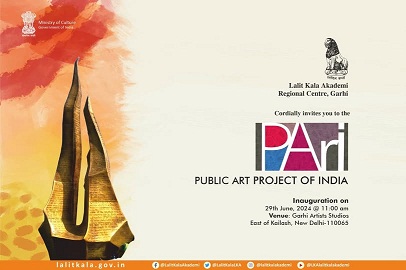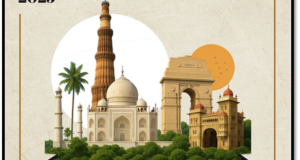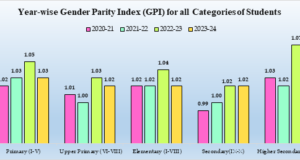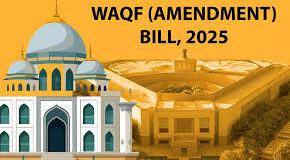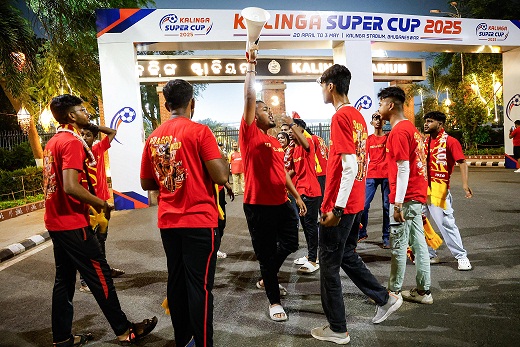The Ministry of Culture, through the Lalit Kala Akademi (LKA) and National Gallery of Modern Arts (NGMA), is committed to the sustainability and maintenance of public art installations created under the
The Ministry of Culture, through the Lalit Kala Akademi (LKA) and National Gallery of Modern Arts (NGMA) are committed to the sustainability and maintenance of public art installations created under the Public Art of India (PARI) project. To ensure the longevity and preservation of these valuable artistic contributions, the LKA, as the nodal agency, has implemented a comprehensive preservation strategy. This strategy encompasses:
- Regular Inspection and Maintenance: Periodic assessments are conducted to identify and address any conservation needs promptly.
- Environmental Protection: Measures are taken to safeguard artworks against environmental factors, minimizing deterioration.
- Restoration and Conservation: Expert interventions are employed to repair and restore any wear or damage, ensuring the integrity of the installations.
Through these dedicated efforts, the Ministry of Culture, aims to ensure that the PARI project’s public art installations remain a lasting testament to India’s rich artistic heritage, continuing to inspire and engage the public for generations to come.
The Ministry of Culture, through Project PARI, aims to promote India’s diverse regional art forms internationally by leveraging the project’s transformation of Delhi’s public spaces into vibrant artistic landmarks. Showcasing a rich blend of traditional styles like Phad, Thangka, Gond, and Warli, created by over 200 artists, PARI serves as a compelling visual journey for both national and international audiences. By acting as an open gallery, it provides tangible exposure to India’s artistic heritage.
The Ministry of Culture has taken steps to ensure the ongoing accessibility and public engagement with the artwork created under Project PARI by strategically placing the vibrant, traditional Indian art installations in prominent public spaces across Delhi, such as Mehram Nagar, Africa Avenue, and the ITO Skywalk, the project has integrated art into the daily lives of citizens, transforming these spaces into permanent cultural landmarks. This deliberate placement ensures sustained public exposure and interaction with the artworks.
To further enhance accessibility and provide contextual information, QR codes have been installed at each location. These QR codes allow visitors to easily access details about the project, its vision, and the specific artistic expressions showcased. This digital component facilitates a deeper understanding and appreciation of India’s rich artistic heritage, encouraging continued engagement beyond the initial event.
At present, the ‘Public Art of India’ (PARI) project has been implemented only in Delhi. It was a significant initiative launched by the Ministry of Culture. Its objective was to revitalize public spaces through art and showcase our cultural heritage during the 46th Session of the World Heritage Committee.
This information was given by Union Minister for Culture and Tourism Shri Gajendra Singh Shekhawat in a written reply in Rajya Sabha today.
(PARI) project. To ensure the longevity and preservation of these valuable artistic contributions, the LKA, as the nodal agency, has implemented a comprehensive preservation strategy. This strategy encompasses:
- Regular Inspection and Maintenance: Periodic assessments are conducted to identify and address any conservation needs promptly.
- Environmental Protection: Measures are taken to safeguard artworks against environmental factors, minimizing deterioration.
- Restoration and Conservation: Expert interventions are employed to repair and restore any wear or damage, ensuring the integrity of the installations.
Through these dedicated efforts, the Ministry of Culture aims to ensure that the PARI project’s public art installations remain a lasting testament to India’s rich artistic heritage, continuing to inspire and engage the public for generations to come.
The Ministry of Culture, through Project PARI, aims to promote India’s diverse regional art forms internationally by leveraging the project’s transformation of Delhi’s public spaces into vibrant artistic landmarks. Showcasing a rich blend of traditional styles like Phad, Thangka, Gond, and Warli, created by over 200 artists, PARI serves as a compelling visual journey for both national and international audiences. By acting as an open gallery, it provides tangible exposure to India’s artistic heritage.
The Ministry of Culture has taken steps to ensure the ongoing accessibility and public engagement with the artwork created under Project PARI by strategically placing the vibrant, traditional Indian art installations in prominent public spaces across Delhi, such as Mehram Nagar, Africa Avenue, and the ITO Skywalk, the project has integrated art into the daily lives of citizens, transforming these spaces into permanent cultural landmarks. This deliberate placement ensures sustained public exposure and interaction with the artworks.
To further enhance accessibility and provide contextual information, QR codes have been installed at each location. These QR codes allow visitors to easily access details about the project, its vision, and the specific artistic expressions showcased. This digital component facilitates a deeper understanding and appreciation of India’s rich artistic heritage, encouraging continued engagement beyond the initial event.
At present, the ‘Public Art of India’ (PARI) project has been implemented only in Delhi. It was a significant initiative launched by the Ministry of Culture. Its objective was to revitalize public spaces through art and showcase our cultural heritage during the 46th Session of the World Heritage Committee.
This information was given by Union Minister for Culture and Tourism Shri Gajendra Singh Shekhawat in a written reply in Rajya Sabha today.
 Odisha news today, Latest Oriya News Bhubaneswar Online Odia news Portal
Odisha news today, Latest Oriya News Bhubaneswar Online Odia news Portal
